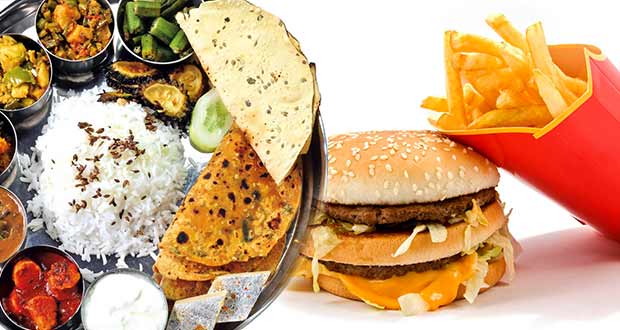If you’ve ever eaten in the United States in a restaurant that specializes in Indian cuisine, then you’ve almost certainly had “Indian” food at some time in your life. These kinds of businesses may be found all around the United States. It is typical practice to provide lunch in the manner of a buffet, with selections like chicken tikka masala, naan bread, and samosas as some of the foods that may be chosen. On the other hand, what the great majority of people in the United States refer to as “Indian cuisine” is really a method of cooking that was developed in the United Kingdom and was influenced by Indian food. This style of cooking is known as “tandoori.” The traditional cuisine of India is quite different from what we are used to eating in the United States. It is loaded with a wide range of intense flavors and spices, most of which the great majority of people in the United States are probably not familiar with.
Your internet search for “Indian food near me” has so far shown poor results; nonetheless, Tikka Shack is the place to go if you want to enjoy true Indian cuisine; yet, the results of your search have not yet been offered to you at this time. The really authentic Indian cuisine, along with the buzzing environment, creates an unforgettable dining experience that is difficult to forget. Do you not find yourself hankering for a meal at a nice establishment at all? The classic dishes of Indian cuisine may be purchased in advance via their website and then enjoyed in the comfort of one’s own home by themselves or with the company of loved ones.
Continue reading in order to get a grasp of the differences between westernized Indian cuisines and traditional Indian meals, as well as the reasons why Indian food, in whatever shape it may take, is a suitable option for any occasion.
Different Spices
A number of well-known spices and herbs, such as cardamom, turmeric, cumin, nutmeg, coriander, and chili powder, are often used in traditional Indian cuisine. Other examples include chili powder. In order to create a wide range of flavors and subtleties, the cuisine of each region in India employs its very own one-of-a-kind mix of these spices. This is done in order to generate a diversity of tastes. The rich taste and aroma of the dinner may be attributed to the myriad of distinct flavors that are layered into Indian cuisine. As a result of this, the meal has a lot of depth.
On the other hand, westernized Indian food often makes use of fewer spices and puts a greater focus on ingredients like butter or heavy cream, both of which are unusual in traditional Indian recipes. This is because westernized Indian cuisine was influenced by western cuisine. Because of this, the flavor is more muted, and as a consequence, it is more suited to the taste receptors of those who are from the West. In addition, westernized versions of Indian food may replace whole spices with pre-made curry powders, which may result in a different flavor profile for the meal as a whole.
The experiences that are elicited by traditional Indian cuisine and the more westernized types of Indian food are, in general, quite unlike one another in terms of the feelings that are produced. The Americanized versions of classic Indian meals have been created with the intention of providing a flavor that is less intense, and that is more accessible to diners whose tastes are diverse. This is in stark contrast to the traditional cuisine of India, which is renowned for the complex way in which different flavors interact with one another. It is commonly accepted knowledge that authentic Indian food has a deeper and more complex degree of taste. As a result, it is very necessary to have an awareness of the distinctions that exist between these two approaches to the cooking of food in order to get an accurate representation of the flavors associated with Indian cuisine.
Less Oil
Authentic Indian food, as opposed to westernized Indian cuisine, has a tendency to be lighter and healthier than its westernized equivalent. Westernized Indian cuisine has been influenced by western cooking techniques and ingredients. This is owing to the fact that traditional cuisines need a smaller quantity of oil, but other recipes that have been westernized call for a greater quantity of oil to be used in the preparation. Traditional Indian food is characterized by the extensive use of a variety of spices, which are then mixed together to provide a more nuanced flavor profile. This is one of the cuisine’s defining characteristics. As a direct consequence of this, the meal is served at a hotter temperature than its westernized counterparts would be served at. In addition, the vast majority of classic recipes demand the food to be cooked over a moderate flame for a considerable amount of time. This assists in bringing out the natural tastes that are already present in the dish’s various components.
When compared to its westernized version, traditional Indian food is far higher in the minerals and antioxidants that are essential to human health. [Citation needed] [Citation needed] [Citation needed] In comparison to meals made in a western style, this one has a much reduced total calorie and fat content due to the absence of any added fats or oils in its composition. It has been proved that spices deliver a variety of health benefits, including an improvement in the function of the immune system and help with digestion. One of the other health benefits of spices is their ability to aid digestion. Real Indian food is, without question, better than its westernized form in terms of both the nutritional content and taste, despite the fact that westernized Indian cuisine does have a place in the world of gastronomy.
Veggies
Rice, beans, lentils, and vegetables may be prepared in a variety of ways to provide delicious meals that do not need the addition of commercial foods or sauces. There is no need for any extra condiments or spices to be used in the preparation of these meals. When compared to other types of meals, traditional Indian cuisine often makes use of a much higher percentage of unprocessed, entire components of its ingredients. In addition, unlike many Westernized forms, traditional Indian cuisine often offers vegetarian choices in addition to meals centered on meat, offering more culinary diversity. This is in contrast to the prevalence of such options in many Westernized forms. In contrast to many Westernized versions, this is a traditional form. The presence of both vegetarian and meat-based dishes in traditional Indian cuisine is one of its most defining characteristics. The term “traditional Indian cuisine” may refer to a lot of different meals, the majority of which center on using meat as the main component. This is owing to the fact that traditional Indian cuisine first emerged on the subcontinent, which is also the area where it can still be found today.
Heat Levels
Because many of the dishes make use of a broad array of spices to generate distinctive taste profiles, authentic Indian food is often spicier than its westernized equivalents. This is because many of the dishes make use of chili peppers. This is due to the fact that westernized adaptations of Indian food often employ less amount of spices. This is due to the fact that a significant number of these recipes demand the use of a large variety of different spices. On the other hand, westernized versions often include fewer spices and a lower overall degree of heat than the traditional variants. This is because they were developed with the intention of appealing to a bigger audience that consisted of individuals whose taste senses were less sensitive. As a result, they had this characteristic. As a direct consequence of this, traditional Indian food tends to be spicier and more flavorful than its more westernized cousin. This is also true of the cuisine of other parts of India. It is essential to bear in mind that the majority of meals from India are prepared in a way that differs from one part of India to another due to regional culinary traditions. As a direct consequence of this, even within the area of traditional Indian cuisine, there is likely to be a great degree of variability in terms of the ingredients used and the tastes that are highlighted. This is because of the fact that there are so many different regions of India.
Summary
Even while there are a lot of distinctions between westernized Indian food and real Indian meals, they do both have one thing in common: they are both quite tasty. Tikka Shack is the place to go if you want to eat the greatest Indian cuisine in the area for the simple reason that they have the best Indian food in the area. This is true regardless of whether you like the more relaxed tastes of the western areas or the exploding flavors of India. Simply check out the menu by clicking here, and then start chowing down!



